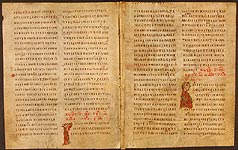Vukan Gospel. Complete Aprakos.
About 1200. Serbian version. One of scribes: Monk Simeon
F (252/256 ı 197/201). I + 189 leaves. Several leaves are missing from the middle part of the text block.
Parchment. Ink, cinnabar, colours.
It is written in a uncial script in two columns by several hands in Rascian spellings.
The illumination of the manuscript contains two images: St John the Evangelist, writing Gospel (fol. 1v), and Jesus Christ Emmanuel (fol. 76r). There are numerous initial letters in the New Byzantine style and the teratological style, where ornament is often interwoven with zoomorphic elements (wolf heads), worked in ink, cinnabar, yellow and green paints. The head-piece in ink on folio 188v is a bar in the form of a zigzag line with dots at turns. The codex includes also small interlaced head-pieces in ink and cinnabar (fols. 178v, 183r, 188r, 189r).
Folio 189v, bearing a note by one of the scribes Monk Simeon, states that the manuscript was produced in Ras, the capital of Rascia, for Prince (Serbian: Zupan) Vukan (Wolf), a son of King Stefan Nemanja of Rascia. However, this information are contained in the revised portion of the note, which, in researchers' opinion, had originally carried the name of Prince (Zupan) Stefan (Stefan the First-Crowned, Nemanja's other son and successor).
The Vukan Gospel is the oldest codex of Aprakos Gospel in the Rascian version. Rascian spellings is often to be found in Serbian medieval manuscripts. Miniatures show the West European influence.
There are unusual initial letters where the wolf head peers out from the interlaced ornament, as if crowning a letter. One leaf from the Vukan Gospel (from the the Orthodox Liturgical Calendar, following fol. 181) are kept in the Library of the Academy of Sciences (Shelfmark: 24.4.2).
In 1883 the Vukan Gospel came into the Imperial Public Library along with the material gathered by Archbishop Porfiry Uspensky.
Shelfmark: –Õ¡. F.Ô.I.82.





